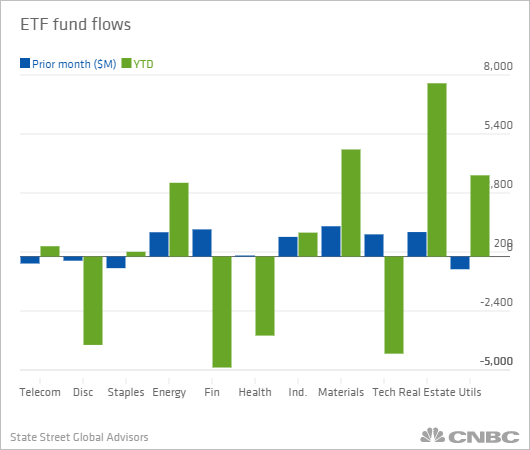sector in the S&P 500, bringing the broad market index up to 11 divisions. The move primarily affects real estate investment trusts (REITs), moving 28 issues with nearly $600 billion in market cap out of the financial sector and into the new real estate heading.
The decision came primarily because officials at S&P Dow Jones Indices believe the industry has become large enough that it should be split from the broader financials that include commercial and investment banks, insurers, brokerages and exchanges.
Practically speaking, there’s an important impact on investors.
Portfolios that track the S&P 500 will have to be readjusted to accommodate the new sector, which is expected to account for just over 3 percent of the total index. Financials, which currently account for about 13.1 percent of the S&P 500, likely will drop below 12 percent.
That means investors looking to achieve balance in their portfolios will have to adjust their allocations accordingly.
Ahead of the move, investors have been piling money into real estate funds. In fact, the sector has generated the largest inflows to exchange-traded funds this year of any of its peers, pulling in $1.08 billion in August alone and $7.6 billion for 2016, according to figures released Thursday by State Street Global Advisors.
Among individual funds, the biggest gainer by far has been the $35.7 billion Vanguard REIT Index Fund, which has pulled in $4.57 billion this year. The $2.87 billion Schwab U.S. REIT ETF has collected $706.2 million, while the $4.3 billion iShares Cohen & Steers REIT fund has had inflows of $355.2 million. (All numbers according to FactSet.)
Investors in the sector have been rewarded. The Vanguard fund is up 12.6 percent year to date, nearly doubling the 6.7 percent that the S&P 500 has returned.
S&P chose Friday to introduce the real estate sector because the day also marks a “triple witching” in the market. The term refers to the expiration of contracts for stock index options, index futures and options during the final hour of trading.
That will give market participants time to reallocate on a day where conditions are conducive to making changes.
“It’s a day with a huge amount of liquidity in the market, trading is faster and more efficient than usual, and it’s a good day for people to rebalance their portfolios,” said David Blitzer, managing director and chairman of the index committee at S&P Dow Jones Indices. “There will be some people who will be rebalancing their portfolios to make sure their weight in real estate is the right weight.”
The sector is part of the Global Industry Classification Standard implemented in 1999 to help investors make sure they could see what was moving the market and make decisions accordingly.
[Source:-CNBC]





